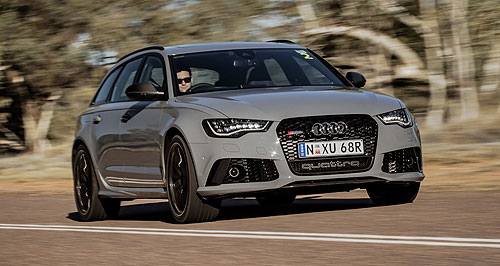Driven: Audi’s most potent road car arrives
BY MIKE COSTELLO | 30th Jul 2013

It may be more than two months away from showrooms, but 30 people have already placed orders on the 412kW/700Nm twin-turbo V8 uber-wagon, which will kick off from $225,000 plus on-road costs.
As such, the load-carrier leaps to the top of the Audi’s growing range of sporty RS models here, supplanting the smaller but conceptually similar RS4 Avant, and the RS5 and TT RS coupes.
Audi sees its RS models as important ‘halo’ models in Australia – a market with a proportionately large number of performance car sales – and as such the company will boost its list of offerings between now and early 2013 to include the RS5 cabriolet, RS7 and RSQ3 hot SUV.
The third-generation RS6 may have less raw power than its 426kW 5.0-litre V10-powered predecessor, but it remains the most potent model in Audi’s global fleet, ahead of the 404kW R8 V10 Plus.
Furthermore, the latest wagon weapon from Ingolstadt is 0.7 seconds faster to 100km/h than the old one, thanks to its 100kg lighter kerb weight – Audi uses more high-tensile steel and 20 per cent aluminium in the body – and extra 50Nm of torque (700Nm compared with 650Nm).
With a 0-100km/h time of 3.9 seconds, the RS6 blurs the line between supercar and regular car. Top speed is electronically governed to either 250km/h – or 280km/h for an extra fee – in Australia, arguably a moot point.
The 4.0-litre twin-turbo V8 under the bonnet is shared with fellow VW Group brand Bentley, and is also featured in a lower-tuned form in the S6 and S7 models. It’s matched to an eight-speed automatic with paddles and sports mode – with the top ratio geared extra tall for cruising.
All 700Nm of torque is available between 1750 and 5500rpm, and the twin-scroll turbos are positioned between the 90-degree ‘V’ to save space. The subsequent extra heat is dispersed through nine radiators, including one just for the intercooler.
The combined-cycle fuel use is cut by a claimed 30 per cent to 9.8 litres per 100km via a new transmission and lighter body, plus the use of idle-stop and cylinder de-activation.
Power is sent to all four corners via the 40:60 front/rear torque-vectoring quattro all-wheel-drive system, while up to 85 per cent of engine load can also be directed to the rear axle. A sports differential can be added, enabling engine torque to be distributed between the rear wheels on a flexible basis, meaning more flows to the outside wheel when cornering.
Quattro GmbH, the Audi arm responsible for RS models, the R8 and Audi racecars, turns 30 this year. Reflecting Audi’s sportier modern focus, its production has risen from 2500 cars in the year 2000 to around 11,500 last year.
Regular RS6 models come with adjustable adaptive air suspension, which firms up or softens depending on which dial-operated driving mode you’re in (choose from comfort, auto, dynamic or individual), and lowers the car by as much as 20mm.
As part of the $4900 Dynamic Package (the one that ups the top speed and also adds more adjustment to the electromechanical steering), Audi will replace the air suspension with steel springs, with three-way adjustable shocks that are connected via diagonally opposed oil lines that send load to the outside-front wheel.
The 1935kg beast is hauled up by 390mm ventilated discs with six-piston black or red callipers behind 21-inch wheels. Enormous 420mm ceramic units will be offered as a $20,490 extra-cost option.
The new version has a longer wheelbase than the old one – 2915mm – liberating more cabin space, but shorter overhangs. With the rear bench folded, Audi claims the RS6 can fit 1685 litres. The rear row can be flipped by latches in the side walls of the cargo area, while a rail system and cargo net are standard fit.
Standard features include a flat-bottomed steering wheel with paddles, LED headlights that automatically dip the high-beam lights, digital TV reception with DAB-plus digital radio, twin RS sports exhausts, head-up display, 21-inch alloy wheels, Audi parking system plus with 360-degree camera, panoramic glass sunroof, front sports seats upholstered in “Valcona” leather and honeycomb stitching, and aluminium fascia inserts.
A Carbon styling pack will set you back $8500, and adds matte black or carbon-finished radiator grille, air intake, roof rails, front sill, rear diffuser and body-coloured door mirrors. The $10,375 Assistance pack adds a night vision camera to detect pedestrians, lane assist, radar-guided cruise control and automated parking.
Lane assist, autonomous crash-sensing brakes and adaptive cruise can be bought separately for $5300, while other features including power-assisted doors ($1140) and a 15-speaker, 1200-watt Bang and Olufsen sound system.
The more powerful but less punchy previous RS6 was on sale between late 2008 and 2010, in which time 65 units were sold here.